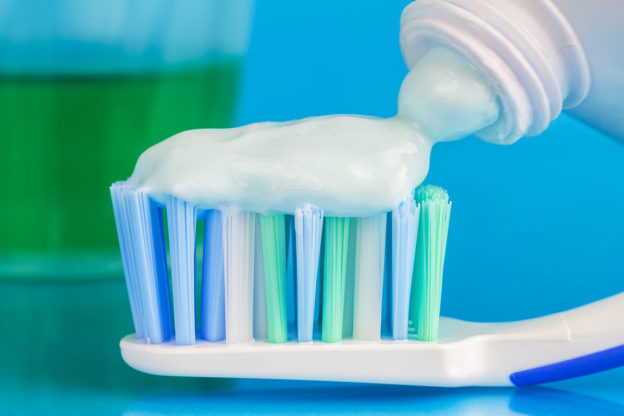By David Blyweiss, M.D., Advanced Natural Wellness
July 17, 2017
- What are you brushing your teeth with?
- Toxic ingredients in your toothpaste
- Safe, non-toxic care for your teeth
These days toothpaste choices are endless. And they’re extremely confusing.
Should you choose the one that promises to whiten your teeth or the one that restores tooth enamel? Is it better to pick a toothpaste that prevents cavities or one that fights plaque and gingivitis?
The truth is, no matter which one you choose, it’s pretty much a given that it contains toxic chemicals.
While this may sound unlikely, toxins in tooth care products is much more widespread than you would think.
You see, when it comes to government regulations, toothpaste falls into a foggy cloud of obscurity. If it contains fluoride, then it’s an approved drug. If it doesn’t, it’s a cosmetic and has almost no health regulations.
This means a lot of harmful ingredients are slipping by regulators and ending up in the toothpaste you expect to keep your smile bright and healthy.
Is Your Toothpaste Toxic?
Open your arteries, improve blood flow for a new health miracle...
Did you know your circulatory system has over 60,000 miles of arteries, veins and other blood vessels, if stretched end to end?
But as you age, your blood vessels undergo changes, which may cause them to stiffen, thicken and get clogged.
GOOD NEWS! Doctors have now identified a “Miracle Molecule” inside your arteries that helps OPEN your arteries and IMPROVE blood flow.
It’s what Dr. Valentin Fuster calls it, "One of the most important discoveries in the history of cardiovascular medicine."To you, that means...
- Healthy blood pressure
- Sharper mind and memory
- Skyrocketing energy and muscular strength
- Increased pleasure and passion in the bedroom
- Improved circulation to every cell and organ in your body
Go here to discover a new natural way to significantly boost the levels of this miracle molecule in YOUR body NOW!
The tissue and membranes in your mouth are extremely effective at absorbing chemicals. This is why doctors advise heart patients to place nitroglycerin pills under their tongue to prevent a heart attack. It speeds up the delivery.
It also means that anything and everything you put into your mouth – lifesaving or otherwise – will immediately make its way into your bloodstream.
So when you’re brushing your teeth, you’re likely get small but dangerous doses of…
Fluoride. If you haven’t already heard the news, fluoride is a neurotoxin. Once it gets into your brain, it can damage your central nervous system. It has a direct link to thyroid gland underactivity via displacing critical iodine from thyroid production and may contribute to Alzheimer’s disease. Animal studies even show it can cause DNA damage and alter gene expression.
We already get too much of this unwanted and unhealthy compound in our water supply. There’s no reason to add to the problem by choosing toothpastes that contain it.
Carrageenan. This highly controversial food additive thickens, stabilizes, and acts as an emulsifier in many processed foods. It’s also a common ingredient in toothpaste.
Well, guess what? This substance is so inflammatory that researchers use it to induce acute inflammation in lab animals when they conduct studies on anti-inflammatory drugs. Additionally, the International Agency for Research on Cancer classifies it as a “possible human carcinogen.” Need I say more?
Formaldehyde. Certain preservatives in toothpaste may release dangerous formaldehyde compounds. This chemical is easily absorbed by both your skin and the mucosal lining of your mouth. At the same time, your toothpaste could release it in the form of a gas that can be inhaled.
The problem is that formaldehyde is a known human carcinogen. And exposure to it is linked to the development of several different types of cancer.
I don’t know about you, but I don’t want this chemical – which is used in embalming fluid – anywhere near me while I’m still living!
The World's Quickest Solution for Ending Prostate and Urinary Misery
This has recently been revealed to be one of the only real breakthroughs in prostate health.
The seeds of a strange fruit (sometimes called "Chinese Apples") hold powerful phytonutrients that are a revolution in prostate health.
In fact, UCLA and Veterans Administration research have now proved this to be true.
Not only that, but it may be the worlds quickest solution for ending prostate misery.
Simply stated, these phytonutrients represent a huge step beyond beta sitosterol, saw palmetto, and other phytosterols alone.
Simply click HERE if you want to have fast prostate relief...restful, uninterrupted sleep...no more constant "urges to go"...enhanced virility...and optimal prostate support for life.
Triclosan. This is an antibacterial ingredient that was banned for use in liquid hand and body soaps last year. But you can still find it in some brands of toothpaste.
This can be a real problem. That’s because it can disrupt your endocrine system and affect levels of your sex hormones. It also suppresses thyroid function, impairs muscle function and promotes liver disease.
Polyethylene Glycol (PEG). This is a humectant that keeps your toothpaste from drying out. But if your toothpaste contains harmful ingredients, PEGs can actually make it easier for those dangerous substances to enter your bloodstream. The higher the PEG number, the easier it is to penetrate the skin and mucosa (i.e., PEG-100 vs PEG-32).
These are only a handful of unwanted ingredients that may be hiding in your toothpaste. This makes it extremely important to choose the safest and most natural tooth care available to you.
The Safest Toothpastes for Your Good Health
I’ll be entirely honest with you.
There are many harmful substances in our world today. And while you can’t avoid all of them, it’s vitally important that you steer clear of the ones you can.
This makes selecting a safe, non-toxic toothpaste a very easy choice. It’s one little thing you can do to can protect your health. And when you combine it with other healthy life choices, it can make a big difference in your life outcome.
The best toothpaste is one you make at home. And baking soda is a great choice for this.
Now, some people use baking soda right out of the box. But you can enhance it by mixing it with coconut oil and a little cinnamon or peppermint essential oil. (Coconut oil acts as an antibacterial to keep your mouth clean, and the oils give you a minty freshness.)
It’s super easy. Just use equal parts baking soda and coconut oil – say 4 tablespoons each – and add 15 or 20 drops of essential oil. Then, blend and brush.
If you’d rather use a toothpaste out of the tube, visit the Cornucopia Institute’s toothpaste scorecard. These folks have done all of the hard for you, and identified the safest toothpastes in America today.
SOURCES:
Valdez-Jiménez L, et al. Effects of the fluoride on the central nervous System. Neurologia. 2011 Jun;26(5):297-300.
Peckham S, et al. Are fluoride levels in drinking water associated with hypothyroidism prevalence in England? A large observational study of GP practice data and fluoride levels in drinking water. J Epidemiol Community Health. 2015 Jul;69(7):619-24.
Mahlberg R, et al. Pineal calcification in Alzheimer’s disease: an in vivo study using computed tomography. Neurobiol Aging. 2008 Feb;29(2):203-9.
Luke J. Fluoride deposition in the aged human pineal gland. Caries Res. 2001 Mar-Apr;35(2):125-8.
H Ling-Fei et al. DNA damage, apoptosis and cell cycle changes induced by fluoride in rat oral mucosal cells and hepatocytes. World J Gastroenterol. 2006 Feb 21; 12(7): 1144–1148.
Everett ET. Fluoride’s Effects on the Formation of Teeth and Bones, and the Influence of Genetics. J Dent Res. 2011 May; 90(5): 552–560.
Behind the Dazzling Smile. Cornucopia Institute. July 2016.
Report on Carcinogens, Fourteenth Edition: Formaldehyde. National Toxicology Program. Department of Health and Human Services. Nov 2016.
Stoker TE, et al. Triclosan exposure modulates estrogen-dependent responses in the female wistar rat. Toxicol Sci. 2010 Sep;117(1):45-53.
Cherednichenko G, et al. Triclosan impairs excitation-contraction coupling and Ca2+ dynamics in striated muscle. Proc Natl Acad Sci U S A 2012 Aug 13;109(35):14158-63.
Yueh MF, et al. The commonly used antimicrobial additive triclosan is a liver tumor promoter. Proc Natl Acad Sci U S A. 2014 Dec 2;111(48):17200-5.







